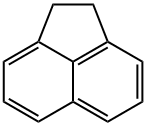Acenaphthene , 98% , 83-32-9
Synonym(s):
1,8-Ethylenenaphthalene;Acenaphthene
CAS NO.:83-32-9
Empirical Formula: C12H10
Molecular Weight: 154.21
MDL number: MFCD00003807
EINECS: 201-469-6
PRODUCT Properties
| Melting point: | 90-94 °C(lit.) |
| Boiling point: | 279 °C(lit.) |
| Density | 1.06 |
| vapor density | 5.32 (vs air) |
| vapor pressure | 10 mm Hg ( 131 °C) |
| refractive index | 1.6048 |
| Flash point: | 135 °C |
| storage temp. | Store below +30°C. |
| solubility | chloroform: 50 mg/mL, clear |
| form | crystalline |
| color | brown-beige |
| Water Solubility | 0.000347 g/100 mL |
| Merck | 14,28 |
| BRN | 386081 |
| Henry's Law Constant | 3.47, 6.21, 10.8, 18.3, and 28.2 at 4.1, 11.0, 18.0, 25.0, and 31.0 °C, respectively (Bamford et al.,
1998) |
| Dielectric constant | 3.0 |
| Stability: | Stable. Incompatible with strong oxidizing agents. |
| LogP | 4.04 at 30℃ and pH5-8 |
| CAS DataBase Reference | 83-32-9(CAS DataBase Reference) |
| IARC | 3 (Vol. 92) 2010 |
| NIST Chemistry Reference | Acenaphthene(83-32-9) |
| EPA Substance Registry System | Acenaphthene (83-32-9) |
Description and Uses
Acenaphthene is a tricyclic aromatic hydrocarbon and crystalline solid at ambient temperature. Acenaphthene does not dissolve in water but is soluble in many organic solvents. Acenaphthene is a component of crude oil and a product of combustion. Acenaphthene occurs in coal tar produced during the high-temperature carbonisation or coking of coal. It is used as a dye intermediate in the manufacture of some plastics and as an insecticide and fungicide. Acenaphthene is a component of crude oil and a product of combustion which may be produced and released to the environment during natural fires. Emissions from petroleum refining, coal tar distillation, coal combustion, and diesel-fuelled engines are major contributors of acenaphthene to the environment. Acenaphthene is an environmental pollutant and has been detected in cigarette smoke, automobile exhausts, and urban air; in effluents from petrochemical, pesticide, and wood preservative industries; and in soils, groundwater, and surface waters at hazardous waste sites. This compound is one among a number of polycyclic aromatic hydrocarbons (PAHs) on U.S. EPA’s (Environmental Protection Agency) priority pollutant list.
Acenaphthene occurs in petroleum bottoms and is used as a dye intermediate, insecticide, and fungicide and in manufacturing plastics.
Safety
| Symbol(GHS) |  GHS09 |
| Signal word | Warning |
| Hazard statements | H410 |
| Precautionary statements | P273-P391-P501 |
| Hazard Codes | Xi,N,T,F,Xn |
| Risk Statements | 36/37/38-50/53-39/23/24/25-23/24/25-11-52/53-67-65-38-51/53-20 |
| Safety Statements | 26-36/37/39-60-61-37/39-45-36/37-16-7-62-36-33-25-9 |
| RIDADR | UN 3077 9/PG 3 |
| WGK Germany | 3 |
| RTECS | AB1000000 |
| Autoignition Temperature | >450 °C |
| TSCA | Yes |
| HazardClass | 9 |
| PackingGroup | III |
| HS Code | 29029080 |
| Hazardous Substances Data | 83-32-9(Hazardous Substances Data) |
| Toxicity | LD50 orally in Rabbit: > 16000 mg/kg |



